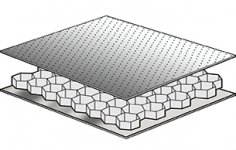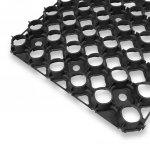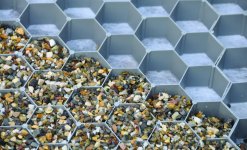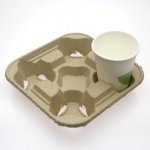This is a product that looks like it'd be excellent for loudspeaker enclosures.
Product
I was thinking: if I made a speaker such that the shell was thin ply (4mm?) and the inner layer was this alu honeycomb, with the perforations facing inward:
-the honeycomb layer would stiffen the cabinet greatly, while only taking up a trifling amount of cabinet volume
-the interior volume of the cabinet would thus be almost as large as the exterior volume
-strength:weight would be very good
The negatives are:
-price is about $400 (Aus) per sheet (2400mm x 1200mm) - estimated based on prices for similar (non perforated) panels from other retailers
-cutting alu = very noisy / different handling to wood (not used to it).
Are there cheaper & nicer to work with options that would achieve the same results?
I considered a couple of ways, e.g.
-make the 'honeycomb' panel by cutting a lot of cardboard poster tubes into 5cm lengths, and sandwiching those between two layers of thin ply, with the inner-facing ply layer being perforated.
Is there anything that'd involve less work, e.g. is there an off-the-shelf source of honeycomb material that isn't prefinished (both sides sealed)?
Product
I was thinking: if I made a speaker such that the shell was thin ply (4mm?) and the inner layer was this alu honeycomb, with the perforations facing inward:
-the honeycomb layer would stiffen the cabinet greatly, while only taking up a trifling amount of cabinet volume
-the interior volume of the cabinet would thus be almost as large as the exterior volume
-strength:weight would be very good
The negatives are:
-price is about $400 (Aus) per sheet (2400mm x 1200mm) - estimated based on prices for similar (non perforated) panels from other retailers
-cutting alu = very noisy / different handling to wood (not used to it).
Are there cheaper & nicer to work with options that would achieve the same results?
I considered a couple of ways, e.g.
-make the 'honeycomb' panel by cutting a lot of cardboard poster tubes into 5cm lengths, and sandwiching those between two layers of thin ply, with the inner-facing ply layer being perforated.
Is there anything that'd involve less work, e.g. is there an off-the-shelf source of honeycomb material that isn't prefinished (both sides sealed)?
Attachments
Last edited:
...-the honeycomb layer would stiffen the cabinet greatly, while only taking up a trifling amount of cabinet volume....
Is it stiffer?
Assume 6mm panel with 0.9mm Al sheet each side.
Compare 6mm wood. The stuff in the center of the solid wood adds little to stiffness. Figure 3mm wood actually working, 1.5mm each side.
So what is the relative stiffness of 0.9mm Al vs 1.5mm wood?
Wood (along grain) 1.60
Aluminum 10
Ah, OK, Al wins by a large margin, especially since (except narrow panels) half the wood grain is wrong way.
...a lot of cardboard poster tubes into 5cm lengths, and sandwiching those between two layers of thin ply...
5cm 50mm is a LOT thicker than that metal honeycomb or even traditional speaker wood. There is NO doubt that THE way to stiffness is thickness. 2X thick is 8X stiffer. The prime point of honeycomb for thickness is that you get your top/bottom material spaced-apart and yet closely supported against buckling. (That 6mm ship-bilge stuff is probably not about stiffness except incidentally; it is about very many very tiny spaces to lose sound into. 50% absorption @ 250Hz is incredible for 1/4" stuff.)
Thanks for the reply, but you missed a key point.
If you look at the other tabs on that link, you'll see
"Panel Thickness
Made to order, minimum thickness 6mm,
standard thickness 40mm"
Agree, agree, agree.
I'm just hoping somebody can point me to an off-the-shelf or low labour solution that does exactly this, without a big penalty (cost, weight, or bulk).
Is it stiffer?
Assume 6mm panel with 0.9mm Al sheet each side.
If you look at the other tabs on that link, you'll see
"Panel Thickness
Made to order, minimum thickness 6mm,
standard thickness 40mm"
There is NO doubt that THE way to stiffness is thickness. 2X thick is 8X stiffer. The prime point of honeycomb for thickness is that you get your top/bottom material spaced-apart and yet closely supported against buckling.
Agree, agree, agree.
I'm just hoping somebody can point me to an off-the-shelf or low labour solution that does exactly this, without a big penalty (cost, weight, or bulk).
Last edited:
Aerolam needs to be laminated on both surfaces otherwise stiffness is ****. Stiffness of any beam is proportional to the square of the thickness..
10mm Aerolam with 3 layers of 160g bias glass either side will be very stiff. That said, nomex is even lighter, just as stiff and much easier to bond.
10mm Aerolam with 3 layers of 160g bias glass either side will be very stiff. That said, nomex is even lighter, just as stiff and much easier to bond.
filling said honeycomb with expanding foam insulation
If I was going to do that, I think I'd simply use a 'sandwich' laminate, such as
PLY
glue
FOAM (e.g. 50mm knauf insulation foam board)
glue
PLY
This would be fine for outdoor speakers, where the additional bulk of having >5cm thick walls doesn't matter.
For indoor use, I'm looking for something where the thick wall is largely an open framework, that does NOT reduce the volume of the enclosure.
Constant Vibration over time can soften or weaken the inner structure honeycomb so it would be best in small area configurations as to not put bending pressure to large unsupported panels.
Many many years ago a ski company called Hexel made light weight skis everybody was talking about using this technogoly, until.,,., bending forces completely destroyed the inner
Structure rendering them useless in short order. A lessen can be learned from that.
So what is stiff in the beginning might not be later on unless it was specifically designed to handle such an environment
Regards
David
Many many years ago a ski company called Hexel made light weight skis everybody was talking about using this technogoly, until.,,., bending forces completely destroyed the inner
Structure rendering them useless in short order. A lessen can be learned from that.
So what is stiff in the beginning might not be later on unless it was specifically designed to handle such an environment
Regards
David
Have you thought about filling said honeycomb with expanding foam insulation? Might as well get *some* CLD in the process.
For CLD, you can't have the inner and outer layer touching.
IE, if you made a CLD composite of fiberglass with a foam core, you're going to screw up the composite properties if you put something in there that joins the inner and outer layer.
I picked up some of the gravel grid stuff to experiment with - the black one from post 4. It is strong enough to drive on, and structurally is exactly what I want.
The weight is 3.8kg / m^2, which is about the same as 6mm ply. Not bad, but less weight would be nice.
A lighter - and cheaper - option would be to make the filler (lattice) layer from a suitable moulded cardboard item, such as coffee or fruit trays. Most household doors are made this way - a cardboard lattice skinned with a thin sheet of ply.
The cardboard could be painted with something like polyester resin (acetone thinned, so it wicks into the fibres) for better strength and durability, without much additional weight - I think a litre of resin would go a long way.
The weight is 3.8kg / m^2, which is about the same as 6mm ply. Not bad, but less weight would be nice.
A lighter - and cheaper - option would be to make the filler (lattice) layer from a suitable moulded cardboard item, such as coffee or fruit trays. Most household doors are made this way - a cardboard lattice skinned with a thin sheet of ply.
The cardboard could be painted with something like polyester resin (acetone thinned, so it wicks into the fibres) for better strength and durability, without much additional weight - I think a litre of resin would go a long way.
Attachments

The reason that the founder of Ikea is worth fifty nine billion dollars is because he figured out that you could make furniture cheaper if you made it out of cardboard instead of wood. Almost all Ikea furniture is a CLD laminate of wood and cardboard, which is then painted.
Prior to Ikea, a lot of cheap furniture was made out of particle board. Ikea furniture has a few advantages over particle board:
1) Because stiffness goes up exponentially with thickness, an Ikea table won't "sag." IE, if you made a cheap dining room table out of particleboard, it would sag because it's thin, and that would look ugly.
2) A CLD laminate is much lighter than particleboard, and that saves tremendously on shipping costs.
3) You wouldn't want to make a table or shelf out of HDF, it would be heavy and expensive. By using HDF on the outside of the laminate, IKEA furniture is scratch resistant and has an attractive finish. Particle board, by comparison, isn't as scratchproof and also has an ugly rough texture.
CLD kinda changed the furniture game.
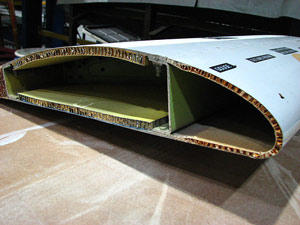
I'm not sure if Ikea did it first or if aerospace did. Here's a flap from a 747 jet, note that it's a similar construction.
Last edited:
Nice summary.
At first glance, this looked like a $2 build from the 'foamcore' thread
I've begun playing with bamboo partly for this reason - the good surface hardness.
I considered contacting a door factory to try to source the exact same cardboard core that they (and Ikea) use. The problem is that the way they honeycombing is structured, the cells are all individual airspaces. This air volume wouldn't be 'seen' by the woofer, it would reduce the effective speaker volume, unless the inner panel was perforated with a huge number of holes.
I picked up a lattice / structure with communication between the air spaces cos it will be much easier to vent into the main airspace.
Here's a flap from a 747 jet, note that it's a similar construction.
At first glance, this looked like a $2 build from the 'foamcore' thread
By using HDF on the outside of the laminate, IKEA furniture is scratch resistant and has an attractive finish.
I've begun playing with bamboo partly for this reason - the good surface hardness.
I considered contacting a door factory to try to source the exact same cardboard core that they (and Ikea) use. The problem is that the way they honeycombing is structured, the cells are all individual airspaces. This air volume wouldn't be 'seen' by the woofer, it would reduce the effective speaker volume, unless the inner panel was perforated with a huge number of holes.
I picked up a lattice / structure with communication between the air spaces cos it will be much easier to vent into the main airspace.
Wow, that's a great idea! I'd never thought of that.
You could build a loudspeaker out of Ikea furniture, and drill holes in the inside surfaces so that the airspace of the entire structure is usable.
For instance, if you made a 12" cube out of IKEA shelves, the inner volume would be just 8" x 8" x 8", or 0.29 cubic feet.
But if you took out a drill and perforated the inner walls, you could get nearly the entire airspace, or about 1 cubic foot.
You could build a loudspeaker out of Ikea furniture, and drill holes in the inside surfaces so that the airspace of the entire structure is usable.
For instance, if you made a 12" cube out of IKEA shelves, the inner volume would be just 8" x 8" x 8", or 0.29 cubic feet.
But if you took out a drill and perforated the inner walls, you could get nearly the entire airspace, or about 1 cubic foot.
Wow, that's a great idea! I'd never thought of that.
Hooray
But if you took out a drill and perforated the inner walls, you could get nearly the entire airspace, or about 1 cubic foot.
Yep ...but , from the image you posted, it looks like the cell structure of the honeycomb is pretty small, so thousands of holes would be required.
Look for it in the form of radiator protectors for race cars - I've found that's a lot cheaper than whole sheets. Honeycomb Radiator Protector, 19 x 26 Inch
Here's one place that sells paperboard honeycomb, which I think is what's used for non-solid doors. Save On Discount Utrecht Honeycomb Board Sheets & More Corrugated Cardboard at Utrecht
Here's one place that sells paperboard honeycomb, which I think is what's used for non-solid doors. Save On Discount Utrecht Honeycomb Board Sheets & More Corrugated Cardboard at Utrecht
For CLD, you can't have the inner and outer layer touching.
IE, if you made a CLD composite of fiberglass with a foam core, you're going to screw up the composite properties if you put something in there that joins the inner and outer layer.
Promise you it's done frequently and that the foam acts as an effective dampener as you get shear loss through both the composite surface and all the flex in the honeycomb. As explained to me afterwards, this would defeat the design goal put forth, though.
On consideration, the plastic stuff I've already acquired seems hard to beat. It ticks almost all the boxes, the main flaw being the (relatively) high weight.
However, in the context of a whole project, the plastic's weight will not be much of the total. I'm considering a sandwich of:
5mm bamboo (outer skin / aesthetic layer)
4mm ply (backing for the bamboo)
4mm ply (inner skin, with cutouts)
40mm plastic grid (the core)
For a full sheet of material (120cmx240cm or 4'x8') the costs in weight and $ would be:
- 25kg and $172 for the 'wood' component, 13mm thick
- 11 kg and $40 for the plastic core, 40mm thick
...so the core would be roughly 3/4 of the total panel's thickness (53mm), while being substantially less than 1/2 of the total weight and cost.
For comparison, an 18mm sheet of premium birch ply weighs about 35kg, and costs $200 (from the same supplier).
Birch Premium Plywood | Plyco
Aramid sheet is not locally available, as far as I know.
At 'local' prices, a 25mm thick aluminium honeycomp core would cost $440 + delivery (2,500km), which is a lot of money to save a couple of kilos.
To keep the cells of that honeycomp open to the inner airspace, I'd have to use perforated alu as the inner skin (since I don't want to drill 10,000 holes by hand). A 1.6mm sheet would cost $150 (+ delivery), and weigh 4kg more than the ply equivalent.
This would essentially nullify the weight saving of dropping the plastic, so I'd basically just be quadrupling the total price - and getting a slightly thinner panel for it.
However, in the context of a whole project, the plastic's weight will not be much of the total. I'm considering a sandwich of:
5mm bamboo (outer skin / aesthetic layer)
4mm ply (backing for the bamboo)
4mm ply (inner skin, with cutouts)
40mm plastic grid (the core)
For a full sheet of material (120cmx240cm or 4'x8') the costs in weight and $ would be:
- 25kg and $172 for the 'wood' component, 13mm thick
- 11 kg and $40 for the plastic core, 40mm thick
...so the core would be roughly 3/4 of the total panel's thickness (53mm), while being substantially less than 1/2 of the total weight and cost.
For comparison, an 18mm sheet of premium birch ply weighs about 35kg, and costs $200 (from the same supplier).
Birch Premium Plywood | Plyco
Aramid sheet is not locally available, as far as I know.
At 'local' prices, a 25mm thick aluminium honeycomp core would cost $440 + delivery (2,500km), which is a lot of money to save a couple of kilos.
To keep the cells of that honeycomp open to the inner airspace, I'd have to use perforated alu as the inner skin (since I don't want to drill 10,000 holes by hand). A 1.6mm sheet would cost $150 (+ delivery), and weigh 4kg more than the ply equivalent.
This would essentially nullify the weight saving of dropping the plastic, so I'd basically just be quadrupling the total price - and getting a slightly thinner panel for it.
Wow, that's a great idea! I'd never thought of that.
You could build a loudspeaker out of Ikea furniture, and drill holes in the inside surfaces so that the airspace of the entire structure is usable.
For instance, if you made a 12" cube out of IKEA shelves, the inner volume would be just 8" x 8" x 8", or 0.29 cubic feet.
But if you took out a drill and perforated the inner walls, you could get nearly the entire airspace, or about 1 cubic foot.
I think this is a great idea in theory, I see some complication though. You'd essentially be creating many small helmhotlz resonators inside the box. Good thing? Bad thing? That would take some tinkering and some simming. I think it would be a lot more complex interaction than just "woofer sees entire box" though. I'd imagine if not thought about and tuned right you might actually make cabinet resonance worse due to this helmhotlz effect.
Edit: On the flip side, if you thought about the tuning, you might be able to use it to knock down dimensional related resonance

Last edited:
- Status
- This old topic is closed. If you want to reopen this topic, contact a moderator using the "Report Post" button.
- Home
- Loudspeakers
- Multi-Way
- Alu honeycomb panel
